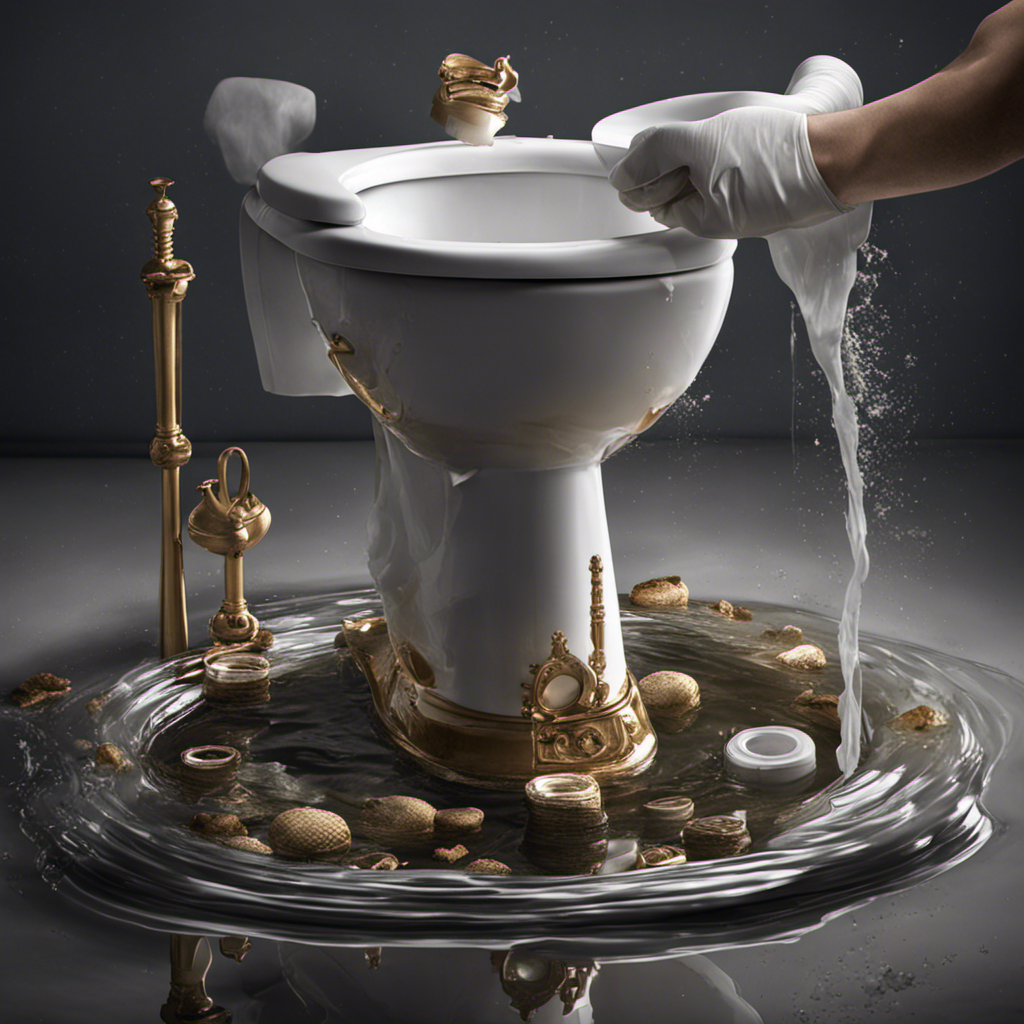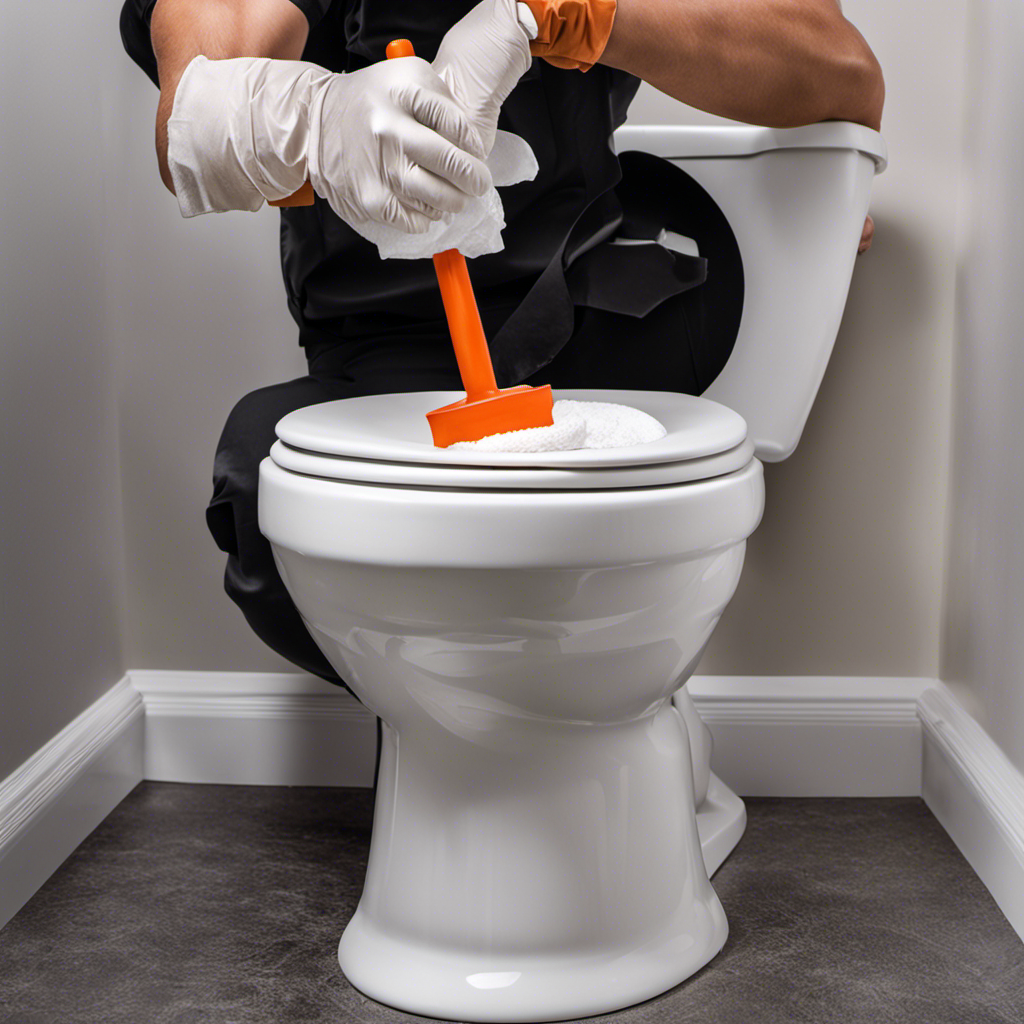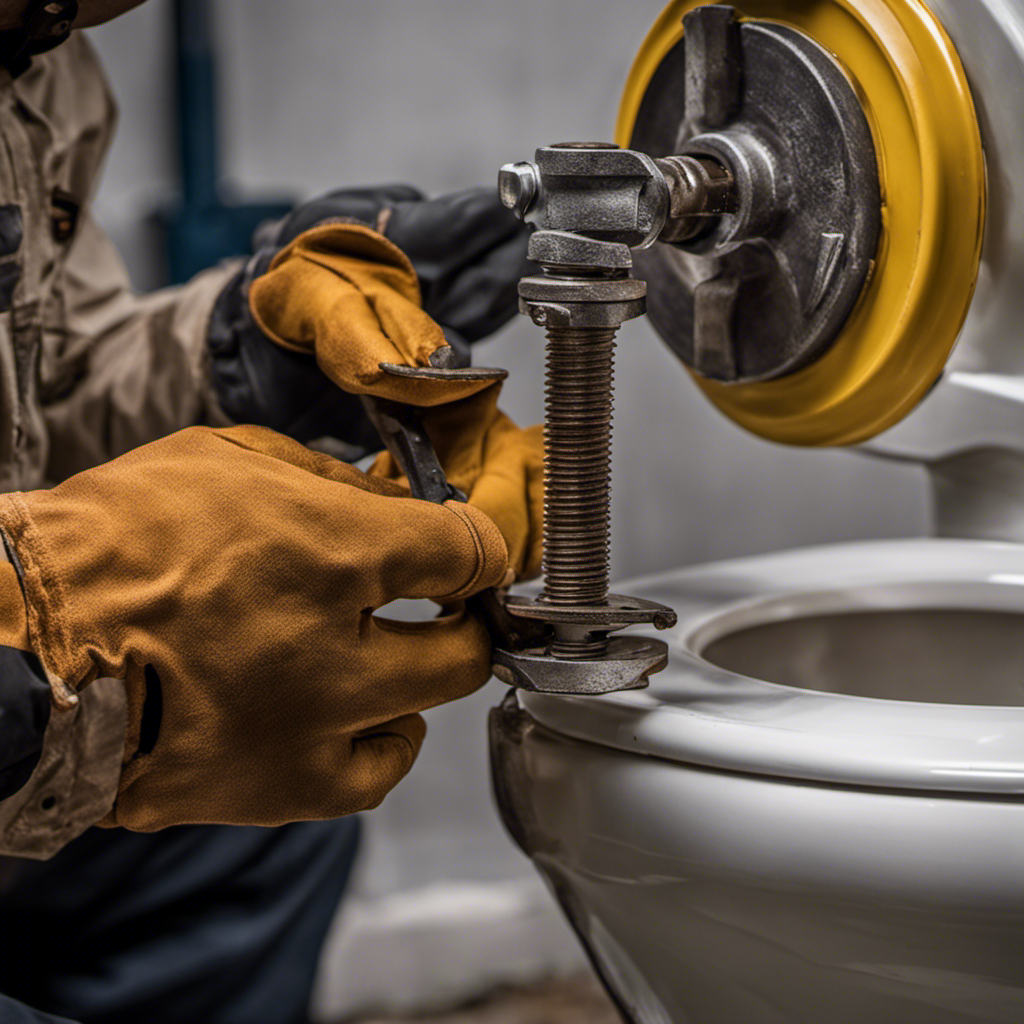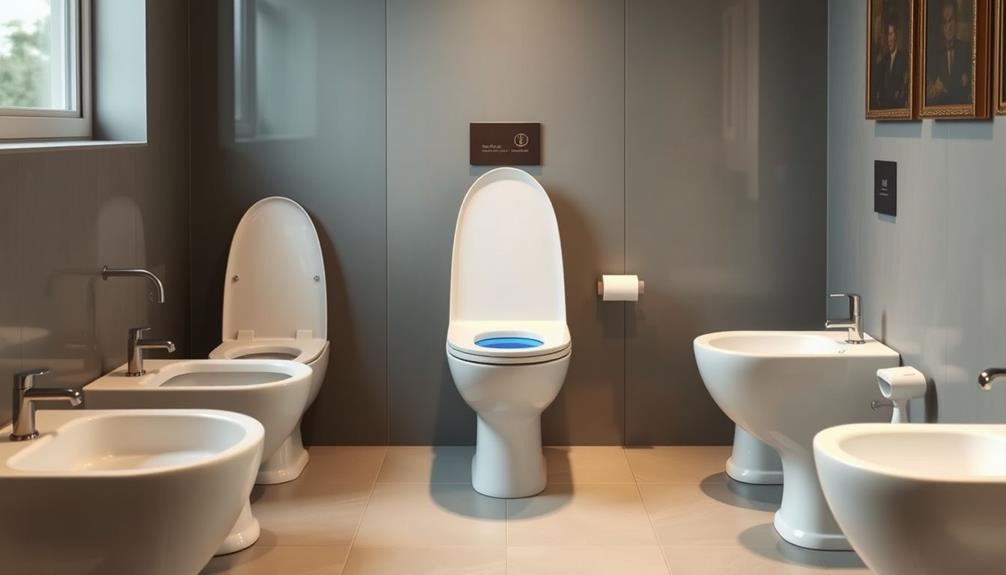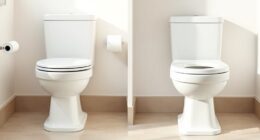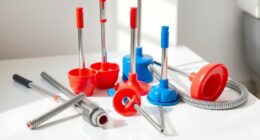Are you tired of dealing with a flooded toilet and the mess it creates? Well, we’ve got you covered! In this article, we’ll show you exactly how to fix a flooded toilet in a few simple steps.
You might be thinking, ‘Can I really do this myself?’ Absolutely! With the right tools and a little know-how, you’ll be able to tackle this common household issue like a pro.
So let’s get started and get that toilet back in working order in no time!
Key Takeaways
- Use a plunger or toilet auger to dislodge clogs and prevent toilet flooding.
- Avoid flushing items that can clog the toilet, such as wipes or feminine hygiene products.
- Regularly clean the toilet bowl and schedule routine maintenance to prevent blockages.
- Take immediate action to address water damage by identifying the source, shutting off the water, and seeking professional help if necessary.
Common Causes of a Flooded Toilet
One of the most common causes of a flooded toilet is a clogged pipe. When a pipe becomes blocked, water cannot flow through it properly, leading to overflow and flooding. Clogs can occur due to various reasons, such as excessive toilet paper usage, flushing foreign objects, or build-up of debris over time.
To prevent this issue, regular toilet maintenance is crucial. Ensure that only toilet paper is flushed down the toilet, and avoid flushing anything else, such as wipes or feminine hygiene products. Additionally, periodic cleaning of the pipes using a plunger or a toilet auger can help prevent clogs.
Assessing the Level of Damage
When dealing with a flooded toilet, it’s crucial to assess the level of damage to determine the appropriate course of action.
This involves identifying the source of the water, determining the extent of the damage, and evaluating repair options.
Water Source Identification
To identify the water source, you can start by checking the shut-off valve behind the toilet. This valve is usually located on the wall near the base of the toilet. Turn it clockwise to shut off the water supply.
If the flooding stops, then you have successfully identified the water source and can move forward with the necessary repairs.
However, if the water continues to flow even after shutting off the valve, it is important to call for professional plumbing services immediately. They have the expertise and tools to handle water damage repair effectively.
Damage Extent Determination
Check for any signs of water damage on the walls, floors, and furniture to determine the extent of the damage. Start by inspecting the walls for discoloration, peeling paint, or bulging surfaces. Look for any water stains or dampness on the floors, especially around the baseboards.
Examine furniture for water rings, warping, or mold growth. It is crucial to identify the full extent of the damage before proceeding with any restoration efforts. Document the damage by taking clear photos or videos for insurance purposes. Depending on your insurance coverage, you may be able to file a claim for the cost of damage restoration.
Contact your insurance provider to understand your policy and initiate the claims process. Remember to act quickly to prevent further damage and to ensure your insurance coverage remains valid.
Repair Options Evaluation
It’s important to evaluate the available repair options before deciding on the best course of action. When it comes to fixing a flooded toilet, there are several repair techniques you can try before seeking professional assistance. Evaluating these options will help you determine if you can fix the problem on your own or if you need to call a plumber.
Here are some repair techniques to consider:
| Repair Option | Description |
|---|---|
| Plunger | Use a plunger to create suction and dislodge the clog. |
| Auger | An auger, also known as a plumber’s snake, can help break up stubborn clogs. |
| Toilet bowl cleaner | Some clogs can be resolved with the help of a toilet bowl cleaner. |
| Hot water | Pouring hot water into the toilet bowl can sometimes melt away the clog. |
| Enzyme-based cleaner | Enzyme-based cleaners can help break down organic clogs. |
Evaluate each option based on the severity of the clog and your comfort level with DIY repairs. If these techniques don’t work, it may be time to seek professional assistance.
Now, let’s move on to the tools and materials you’ll need for the repair.
Tools and Materials You’ll Need
You’re going to need a plunger and a bucket to fix the flooded toilet.
When it comes to toilet repair techniques, troubleshooting toilet issues can be a common problem. But don’t worry, with the right tools and a little know-how, you can fix it yourself.
Start by grabbing a plunger, which will help you remove any clogs. Make sure it has a good seal around the drain and give it a few vigorous plunges.
If that doesn’t work, try using a toilet auger, a flexible tool that can reach deeper into the pipes to remove stubborn clogs.
Additionally, having a bucket on hand is essential for collecting excess water or for adding hot water to the bowl to help break up any blockages.
With these tools, you’ll be able to successfully fix your flooded toilet in no time.
Step-by-Step Guide to Unclogging the Toilet
If you’re dealing with a clogged toilet, understanding the plunger technique is essential. This technique involves creating a seal with the plunger over the drain and using a combination of pushing and pulling motions to dislodge the clog.
Common causes of clogs include excessive toilet paper, foreign objects, and flushing items that should not be flushed.
To prevent clogs, it’s important to avoid flushing anything other than toilet paper and waste, and to regularly maintain your toilet by using a toilet auger or enzyme-based cleaner.
Plunger Technique Explained
To fix a flooded toilet, grab your plunger and position it over the drain, making sure it fully covers the opening. Apply downward pressure and quickly pull up to create suction. Repeat this plunging action several times until the water starts to drain.
If the plunger doesn’t work, try these troubleshooting techniques:
-
Plumber’s Snake: Insert the snake into the drain and rotate it while pushing it forward. This can break up any clogs the plunger couldn’t handle.
-
Hot Water and Dish Soap: Pour a bucket of hot water mixed with dish soap into the toilet bowl. Let it sit for a few minutes, then plunge again. The hot water and soap can loosen the clog.
-
Baking Soda and Vinegar: Pour half a cup of baking soda and half a cup of vinegar into the toilet bowl. Let it sit for a few minutes, then plunge. The chemical reaction can break up the clog.
-
Wet/Dry Vacuum: Use a wet/dry vacuum to suck out the water and any debris clogging the toilet. Be careful not to overflow the vacuum.
These plunger alternatives and troubleshooting techniques can help you fix a flooded toilet quickly and efficiently.
Common Causes of Clogs
One common cause of clogs is flushing excessive amounts of toilet paper down the drain. When you use too much toilet paper and flush it down the toilet, it can easily clog the drain and cause a backup. To prevent this, it’s important to be mindful of the amount of toilet paper you use and to flush it in smaller increments if needed.
Another cause of clogs is flushing items that shouldn’t be flushed, such as feminine hygiene products, cotton balls, or baby wipes. These items can easily get stuck in the pipes and create a blockage. To avoid clogs and the need for expensive repairs, it’s crucial to practice proper toilet maintenance and only flush toilet paper and waste.
Now that you understand the common causes of clogs, let’s move on to some prevention tips to keep your toilet functioning properly.
Prevention Tips for Clogs
Let’s start by discussing some simple ways to prevent clogs in your toilet. Here are four practical tips for toilet maintenance and drain cleaning:
-
Be mindful of what you flush: Only flush toilet paper and human waste. Avoid flushing items like wipes, feminine hygiene products, or excessive amounts of toilet paper, as they can easily clog your toilet.
-
Use a drain screen: Place a drain screen over your toilet’s drain to catch any debris or small objects that may accidentally fall in. This will prevent them from causing clogs in your toilet’s pipes.
-
Regularly clean your toilet: Scrub the inside of your toilet bowl regularly to remove any buildup or residue that could lead to clogs. Use a toilet brush and a mild cleaner to keep your toilet clean and prevent blockages.
-
Schedule routine maintenance: Consider scheduling professional drain cleaning services at least once a year. A plumber can inspect your toilet’s pipes, remove any stubborn clogs, and ensure proper flow.
Addressing Overflow and Water Damage
First, you need to quickly locate the shut-off valve to prevent further water damage.
Once you have turned off the water supply, it’s time to address the overflow and water damage caused by the flooded toilet. Depending on the severity of the damage, you may need to consider contacting your insurance provider to discuss coverage options.
In some cases, professional water damage restoration services may be necessary to properly assess and repair the affected areas. These professionals have the expertise and equipment to thoroughly dry and sanitize the space, preventing further damage and potential mold growth.
Remember, it’s important to act swiftly to minimize the damage and ensure a safe and clean environment.
Now, let’s move on to the next section on preventing future toilet floods.
Preventing Future Toilet Floods
To prevent future incidents, you should regularly check the condition of the water supply line and promptly address any signs of wear or leakage.
Follow these steps to maintain your toilet and prevent floods:
-
Check water pressure: High water pressure can cause stress on the water supply line, leading to leaks or bursts. Install a pressure regulator to control water pressure and prevent damage.
-
Inspect the supply line: Look for signs of wear, such as cracks or corrosion, on the water supply line. Replace any damaged parts immediately to avoid potential flooding.
-
Ensure proper flushing: Avoid flushing excessive amounts of toilet paper or other materials that can clog the pipes. Regularly clean the toilet to prevent blockages.
-
Conduct regular maintenance: Inspect the toilet components, such as the fill valve and flapper, for any signs of deterioration. Replace worn-out parts to maintain proper functioning and prevent leaks.
Conclusion
In conclusion, it is important to remember to remain calm when encountering a flooded toilet. By following the step-by-step guide and using the proper tools, you can quickly unclog the toilet and prevent further water damage.
Proper prevention is key in avoiding future toilet floods. This includes avoiding flushing excessive toilet paper or foreign objects. By practicing good habits, you can ensure that toilet troubles become a thing of the past.
So, stay savvy, steady, and solution-oriented when it comes to dealing with any toilet troubles that may arise.
